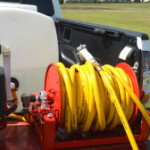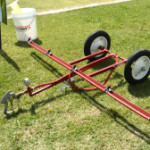Maintaining a healthy landscape often requires application of plant health products. The key to these applications is a properly calibrated sprayer, said Dr. Casey Reynolds, a Texas A&M AgriLife Extension Service state turfgrass specialist in College Station.
“It’s not uncommon when you are managing grasses, whether they are on athletic fields, home lawns or golf courses, that you get impacted by weeds, diseases or insects,” said Reynolds, speaking at a recent turf and landscape event in Dallas. “We all know one of the best ways to manage these is to maintain healthy turfgrass through proper mowing, fertilization, irrigation practices and plant selection.”
But, he said, inevitably there are going to be pests out there. One of the most fundamental things to managing those pests and applying control products is using a properly calibrated sprayer. There are various types of sprayers on the market, from boom-type sprayers to backpack sprayers to landscape skid sprayers, and each is calibrated differently.
“Sprayer calibration itself is very simple,” Reynolds said. “There are multiple ways to do it. I would encourage you to pick a method that works for you and stick with it. Every time you change things, you introduce potential for doubt and miscalibration. What’s important is that you have a known volume of solution and a known area to spray.”
He said for professionals in the landscaping market, efficiency is the name of the game when they have many lawns per day to treat.
Check out the YouTube video here
“You want to know when you get out on the lawn, that if you are calibrated at 30 gallons per acre and you have a 30-gallon tank then you can spray 1 acre of turf. If that product goes out at 1 pint per acre, you put 1 pint in the tank and take off,” Reynolds said. “That’s the kind of confidence and efficiency we want to have in mind.”
When looking at a product label that says to apply 2 to 3 pints per acre in a spray volume of 20 to 260 gallons per acre, keep in mind that it is the spray volume that will impact the area sprayed. He said 40-50 gallons per acre is a commonly used spray volume that often fits a wide range of products.
“The higher you go, the fewer acres you can spray,” Reynolds said. “The main thing is to calibrate to a spray volume that is within the label and fits the lawns you have to manage. Depending on what product you apply, if thorough coverage is extremely important, you might want to bump the spray volume up and make sure you get really good coverage – but the trade-off is you can cover less acres and will have to fill the tank more often.”
Reynolds outlined two common methods of sprayer calibration:

The 1/128th spray method is easily used to calibrate landscape skid sprayers, said Dr. Casey Reynolds, a Texas A&M AgriLife Extension Service state turfgrass specialist in College Station.
The 1/128th spray method, easily used with backpack or landscape skid sprayers, is based on the concept that there are 43,560 square feet in an acre and 128 ounces in a gallon. Instead of spraying an entire acre and collecting the amount of gallons you apply, you simply shrink both numbers by a factor of 128. This allows you to spray a 340 square foot area, which is 1/128th of an acre and collect the spray volume in ounces.
“Just lay off a 340-square-foot area and time how long it takes to evenly spray it with water at the rate you would spray a lawn. Then spray into a bucket for that same amount of time and the ounces you catch is equal to gallons per acre. For example, if it takes 28 seconds to the spray area, then spray into a bucket for 28 seconds. If you catch 60 ounces of water, then the sprayer is calibrated at 60 gallons per acre.

The 5940 method is more appropriate for sprayers with fixed nozzle booms, said Dr. Casey Reynolds, a Texas A&M AgriLife Extension Service state turfgrass specialist in College Station
The 5940 method is more appropriate for sprayers with fixed nozzle booms. In this method,simply calculate gallons per acre or GPA by inserting the appropriate information into the following formula: GPA = GPM x 5940 and miles per hour or MPH x nozzle spacing in inches or NSI.
GPM is obtained by collecting the volume of water coming out of one spray nozzle in one minute and converting it to gallons, MPH comes from either the driving or walking speed, and NSI is simply measured as the number of inches between two adjacent nozzles. A sprayer with a 0.4 GPM nozzle, at 3 mph and 20-inch nozzle spacing provides an output of 39.6 GPA.
“Either way you decide to calibrate, the most important thing is to obtain an accurate spray volume,” Reynolds said. “One tip to improve calibration accuracy is to keep all the factors as consistent as possible between calibration and actual application.
“So, if you calibrate at a certain speed and pressure using a certain type of nozzle, then any application you make should be using the same speed, pressure and nozzles. If any of these are changed, simply go through the calibration process again to obtain a new spray volume.”

 .
.